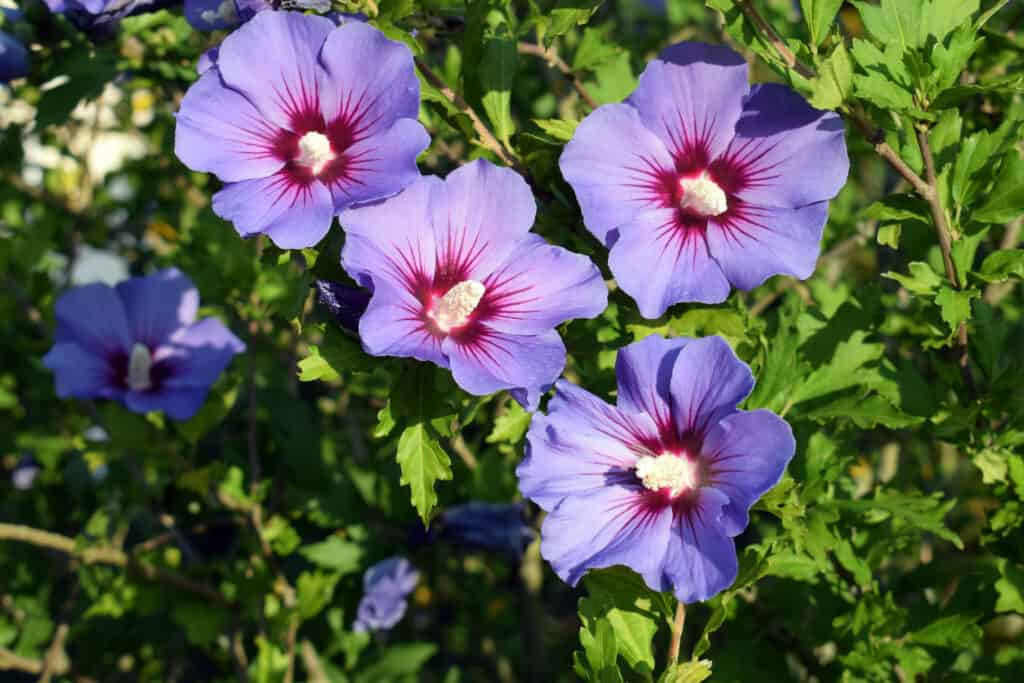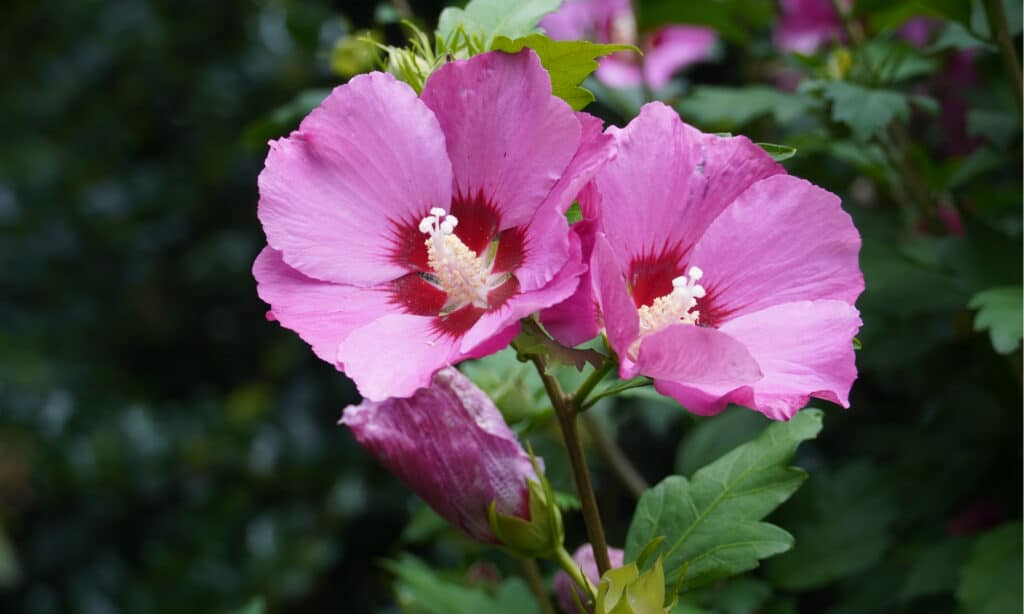The hibiscus syriacus is a deciduous flowering bush with many names. It is called rose mallow, althea, rose of Sharon, and hardy hibiscus. It is an easy-to-grow bush that is nearly invasive in some areas. This plant grows to an impressive size under the right conditions, and it produces lovely flowers when most other plants are finished flowering for the year. Below we will discuss everything you need to know about this popular plant.
Rose of Sharon vs. Hardy Hibiscus: Description

Rose of Sharon, rose mallow, althea, and hardy hibiscus are all common names for the same plant.
©iStock.com/matunka
Large and easy to please would be the best way to describe this plant. It will grow in almost any soil or light, but if given ideal conditions, it will grow to 8-12 feet tall and 6-10 feet wide.
The oval leaves are four inches long, have a toothed edge, and have three lobes. The flowers are cup or vase-shaped and 2-3 inches across. The flowers come in white, pink, red, or purple and all have white stamens with yellow tips.
Rose of Sharon vs. Hardy Hibiscus: Origins
Hibiscus is a member of the mallow family, Malvaceae. This large family includes many species of annual, perennial, herbaceous, woody shrubs and some small trees.
Hibiscus syriacus is native to Korea and China and is widely cultivated by gardeners worldwide. Some records show it may have been brought to Japan by traders as early as the 8th century.
Rose of Sharon vs. Hardy Hibiscus: Uses

The most common use for the rose of Sharon is as a large garden ornamental.
©Heinsdorff Jularlak/Shutterstock.com
The most common use for the rose of Sharon is as a large garden ornamental. Gardeners use the rose of Sharon in many ways; as a tall focal point in the back of the garden, as a stand-alone feature planting, or in multiples as a living fence.
Hibiscus syriacus is edible and is used in Chinese medicine and as a health food in China. The young leaves can be eaten raw or cooked, but often remain tough to chew, but make a delicious tea. The flowers can be eaten raw or cooked and have a slightly nutty taste. Too much of this plant has a diuretic effect, so consume it in small quantities.
Rose of Sharon vs. Hardy Hibiscus: Hardiness
Rose of Sharon, aka hardy hibiscus, is fully hardy to USDA zones 5-9. It can withstand winter temperatures as low as 20 to 25 °F and summer temperatures as high as 90 to 100°F.
Rose of Sharon vs. Hardy Hibiscus: How to Grow

Rose of Sharon will tolerate almost any conditions, including sandy soil and urban pollution.
©iStock.com/peterspiro
When choosing a planting site, you don’t have to be too picky. This plant will tolerate almost any conditions, including sandy soil and urban pollution. But if you aim to please, the ideal site is in full sun and moist, rich soil. Your hardy hibiscus will be indestructible if you can meet these requirements.
Plant in spring or fall when there is no danger of frost. Incorporate a large amount of compost or other organic material into the planting to help the roots remain moist. Cover the soil with a two-inch layer of mulch to prevent water evaporation. Fertilize three or four times during the growing season.
It is an easy plant to propagate, as it readily self-seeds. You will see seedlings all around the mother plant and can dig them up and transplant them to their final location.
Up Next:
- Gardenia vs. Camellia: 5 Key Differences. Here are two more flowering plants to tickle your fancy.
- 7 Blue Perennial Flowers. Blue is not the most common flower color, but this list of perennial flowers in blue will keep coming back year after year.
- 10 Extinct Flowers. Did you know that there are several species of flower that have gone extinct?
The photo featured at the top of this post is © Heinsdorff Jularlak/Shutterstock.com
Thank you for reading! Have some feedback for us? Contact the AZ Animals editorial team.






